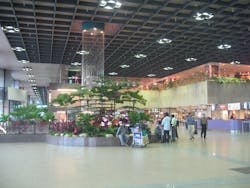SleepingInAirports.com List of Best, Worst Airports
Singapore’s Changi Airport and South Sudan’s Juba International Airport were named the best and worst, respectively in 2017, according to a list compiled by SleepingInAirports.com. The website asked travelers to rate airports around the world based on factors including comfort, services, good options, immigration/security, customer service, cleanliness, ease of navigation and sleepability.
“Year after year, Singapore Changi reigns over airports worldwide as the single best airport in the world. This undisputed victor dazzles and delights travellers with its efficiency, amenities, and absolute comfort,” according to the website. “The airport is positively passionate about accommodating traveller needs - a fact made obvious through their exceptional customer service and their continued drive to make something great even better.”
Overall, Vancouver International Airport was the only North American facility to make the top 10 overall list, coming in at number six. Rounding out the top five were:
- Incheon International Airport, for its “clever activities and amenities” including ice rinks, cultural centres and excellent and affordable dining options, along with free showers, reclining lounge chairs and rest zones
- Tokyo Haneda International Airport, for being impeccably clean and extremely efficient, along with quiet surroundings, plenty of benches without armrests, and pet and human hotels
- Helsinki-Vantaa Airport, for opening the the new South Pier in Terminal 2 that has leather recliners and rocking chairs in a spacious and naturally lit area. It was also praised for its sleep pods and flawless connections into the city centre
- Hong Kong International Airport, for its IMAX theater, a range of dining options for all budgets and tastes and high-quality Wi-Fi
Vancouver was also number one among North American airports. “Year after year, travellers vote it into the number one spot, referencing its cleanliness, friendliness, and overall decor as winning qualities,” according to the website. “Its west coast feel, complete with aboriginal art, panoramic views, and a saltwater aquarium, gives you a sense of the area that you’re in - even if you don't leave the airport. The next four airports on the list are:
- Portland International Airport, for its pop-up market, live music, locally sourced shopping, affordable restaurant prices, naturally-lit terminals free Wi-Fi and loads of charging points
- Tampa International Airport, for having a logical layout, free Wi-FI, a good range of restaurants and loads of power outlets
- Minneapolis – St. Paul International Airport, for offering sleeping mats in Concourse D and the observation deck, being consistently clean and having a good range of shops and restaurants, some of which are open 24 hours a day
- Detroit Metro Airport, for terminals seen as easy to navigate with straightforward gate-to-gate transfers, along with clever attractions like a giant fountain and a light light tunnel.
Three of the top five overall worst airports were in Africa. Juba International Airport was at the top of the heap for myriad valid reasons, not limited to tents that have replaced the terminal which has been under renovations since 2012, rotting plywood floors that that people often fall through, a noticeable lack of seating and a lack of electricity and air conditioning in 100+ degree heat.
The top five was rounded out by Jeddah King Abdulaziz International Airport in Saudi Arabia, Port Harcourt International Airport in Nigeria, Crete Heraklion International Airport in Greece and Lagos Murtala Muhammed International Airport, also in Nigeria.
The first North American airport on the list, LaGuardia, was number 14 on the list of the worst, despite its ongoing major terminal upgrades. It was cited for large crowds, long lines, limited seating, few food and beverage options and how it’s become a refuge for New York City’s homeless.
About the Author

